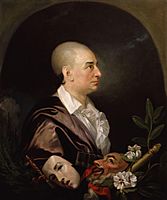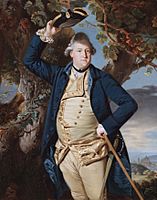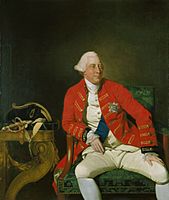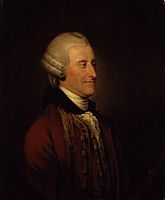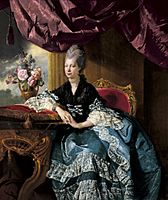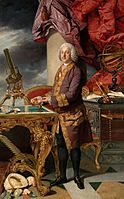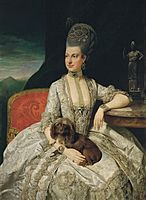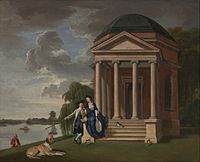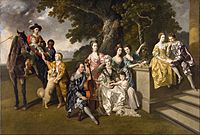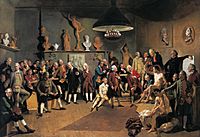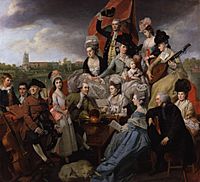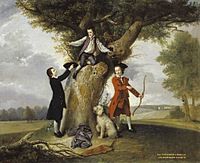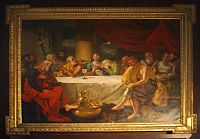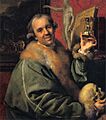Johan Zoffany facts for kids
Quick facts for kids
Johan Zoffany
|
|
|---|---|
| Born |
Johannes Josephus Zaufallij
13 March 1733 Frankfurt, Holy Roman Empire
|
| Died | 11 November 1810 (aged 77) London, England
|
| Nationality | German |
| Known for | Painting |
Johan Joseph Zoffany (born Johannes Josephus Zaufallij; March 13, 1733 – November 11, 1810) was a German painter. He was known for his neoclassical style, which means he often painted scenes inspired by ancient Greek and Roman art. Zoffany worked mostly in England, Italy, and India. His paintings are now in many famous collections, including the National Gallery and the Tate Gallery in Britain.
Contents
Who Was Johan Zoffany?
Johan Zoffany was born in Frankfurt, Germany, on March 13, 1733. His father was a cabinet maker and architect for a royal court. Zoffany started studying art in the 1740s in Germany. He first learned in a sculptor's workshop and later studied with an artist named Martin Speer.
In 1750, Zoffany traveled to Rome, Italy, to continue his art studies. He joined the studio of a painter named Agostino Masucci. In 1760, he moved to England. At first, he worked for a clockmaker, painting designs on clocks.
Becoming a Royal Painter
By 1764, Zoffany became a favorite artist of King George III and Queen Charlotte. He painted many informal scenes of the royal family. One famous painting shows Queen Charlotte getting ready in Buckingham House.
Zoffany was also popular with the Austrian royal family. In 1776, Empress Maria Theresa made him a baron, which is a noble title.
In 1768, Zoffany helped start the new Royal Academy of Arts. He became very popular for his portraits of important people and actors. He painted famous actors like David Garrick, often showing them in their stage costumes.
Master of Group Portraits
Zoffany was very good at a type of painting called a 'theatrical conversation piece'. This was a special kind of 'conversation piece'. A conversation piece is a group portrait, usually informal, showing a family or friends together. This style became popular in Britain around the 1720s. Zoffany is often called the "real creator and master" of this type of painting.
He painted several group portraits that included a cello. These included families like the Cowper-Gore family and the Sharp family. Around 1780, he painted a portrait of a famous cellist and composer named Giacomo Cervetto.
Later in his life, Zoffany became known for huge paintings with many people and artworks in them. Everyone in these paintings would be easily recognizable by people at the time. In paintings like The Tribuna of the Uffizi, he was extremely accurate. He even showed other artworks being brought into the small gallery space from other parts of the Uffizi museum.
Time in India
Zoffany spent several years in India, from 1783 to 1789. While there, he painted portraits of important people like the Governor-General of Bengal, Warren Hastings. He also painted an altarpiece, which is a painting for a church, called The Last Supper (1787) for a church in Calcutta.
One of his most lively paintings from this time is Colonel Mordaunt's Cock Fight (1784–86). After his time in India, Zoffany was shipwrecked off the Andaman Islands on his way back to England.
Zoffany died at his home in Strand-on-the-Green, London, on November 11, 1810. He is buried in the churchyard of St Anne's Church, Kew.
Family Life
Around the age of 27, Zoffany married a woman from Germany. She came with him to London but later returned to Germany.
In 1772, Zoffany went to Florence, Italy. A young woman named Mary Thomas, whose father was a glovemaker in London, followed him there. She was expecting his first child. It's not certain if they married in Europe, but a portrait of her from around 1781–82 shows her wearing a wedding ring.
After his first wife died in 1805, Zoffany officially married Mary Thomas in England. Johan and Mary Zoffany had five children together. These included a son who died as a baby and four daughters.
His Art's Legacy
Even though Zoffany was a very important painter in his time, his work was not always studied much by art historians until recently. In 1920, the first detailed study of his life and work was published.
Later, in 1966, a book about his famous painting Zoffany and his Tribuna was released. In 1977, an exhibition of his work was held at the National Portrait Gallery, London.
More recently, in 2009, a full biography called Johan Zoffany: Artist and Adventurer was published. This book followed Zoffany's journey from his early life in Germany to his success as a portrait painter and his time in India. It included many of his works, some of which were in private collections.
In 2011, another important book about Zoffany was published. Also, in 2011–12, two art galleries held a major exhibition of his work called Johan Zoffany, RA: Society Observed. These recent studies have helped people appreciate Zoffany's art more.
A 2014 book described Zoffany's friendship and business relationship with Robert Sayer. Sayer was a publisher who made prints of Zoffany's paintings. This helped Zoffany become famous around the world. Zoffany even painted a group portrait of Sayer's family in 1781.
Zoffany in Pop Culture
Zoffany's name has appeared in popular culture.
- In the comic opera The Pirates of Penzance, a character brags about being able to tell Zoffany's paintings apart from others.
- A scene in the film Barry Lyndon (1975) is said to have been inspired by Zoffany’s Tribuna of the Uffizi painting.
- There is a street in Archway, London, named Zoffany Street after him.
Works
- Portraits
-
David Garrick in Vanbrugh's Provoked Wife, Theatre Royal, Drury Lane 1763
-
George III 1771
-
John Montagu, 4th Earl of Sandwich, best known as inventor of the sandwich.
- Others
-
Queen Charlotte with her Two Eldest Sons (1765)
-
The Family of Sir William Young (circa 1768)
-
Sir Lawrence Dundas and his Grandson Lawrence (c. 1775)
-
Lalbagh Fort, Dhaka (1787)
Images for kids
-
Zoffany's former house at 65 Strand-on-the-Green, Chiswick, London
-
Charles Towneley in his Sculpture Gallery (1782), Towneley Park collection
See also
 In Spanish: Johann Zoffany para niños
In Spanish: Johann Zoffany para niños



